PRINCETON, NJ -- Gallup Poll tracking shows that 45% of Americans are now reporting that they have received their tax rebate, but finds little apparent effect of these rebates on consumer attitudes.
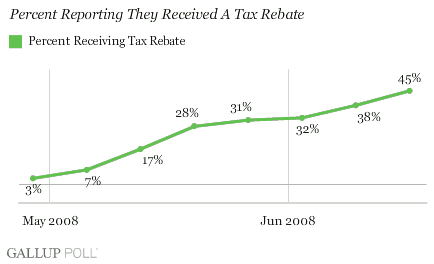
In late April, the IRS began sending out tax rebates to an estimated 130 million American families and households. Gallup Poll tracking data document the degree to which the rebates have made their way into Americans' bank accounts or mailboxes, with the percent reporting having received their rebate jumping from a minimal 3% in late April to the current 45%. The last checks are scheduled to be distributed on July 11.
Tax Rebates by Income
As might be expected by the way the tax rebate legislation was designed, a higher percentage of middle-income Americans report receiving a tax rebate than do those having lower incomes or those with higher incomes. Gallup's survey results for the seven-day period, June 10-16, show 54% of those making $24,000 a year but less than $60,000 and 57% of those making $60,000 a year but less than $90,000 have already received their tax rebate. Not surprisingly, only 31% of those making less than $24,000 a year have gotten a rebate since many of these Americans do not pay federal taxes. Similarly, only 40% of those making $90,000 or more a year report receiving a tax rebate since the rebates begin phasing out once an individual's annual income exceeds $75,000 or a couple's exceeds $150,000.
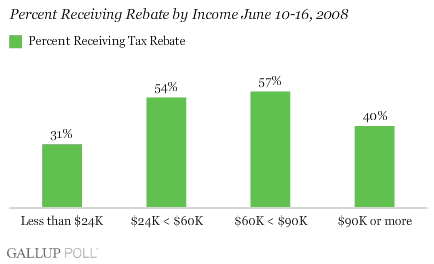
Looking over the entire aggregated sample of those interviewed during the rebate period (with interviews beginning April 27 and extending through June 17) provides a very large sample in which more fine-tuned income categories can be examined. (Because this large time period includes the early days of the rebate distribution period, the overall percentages of those reporting rebates across the entire sample are lower.) On this more refined income basis, it appears that the highest percentage of tax rebates are going to those with incomes of between $36,000 a year but less than $120,000 a year.

Consumer Confidence and Tax Rebates
The main purpose of the stimulus legislation was to help the economy by "stimulating" consumer spending. Although reports indicate that May retail spending did increase, the day-by-day analysis of Gallup's tracking data (displayed above) shows that rebate penetration was quite low as May began and had only reached about a third of all adults by the time May ended. Furthermore, an analysis of rebate data shows that there is very little relationship between an individual having received the rebate and a positive change in his or her economic attitude.
As an example, and consistent with an earlier Gallup analysis of rebate data, the billions of dollars in tax rebates that have already been distributed to millions of Americans has apparently done nothing to improve overall consumer confidence in the U.S. economy. When asked to rate current economic conditions, 43% of those who have already received their tax rebates rate the U.S. economy as "poor" and 16% rate it as "excellent" or "good," while 44% of those who have not received a rebate rate the economy as "poor" and 16% rate it as "excellent" or "good."
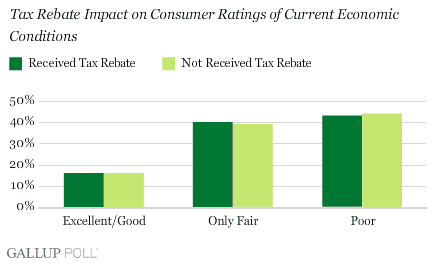
Similarly, 88% of those who have already received a rebate say economic conditions in the country as a whole are getting worse, not better, while 86% of those who have not received a rebate agree things are getting worse -- meaning both groups essentially hold the same view.
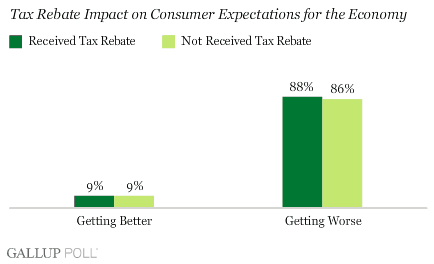
Worried About Money and Tax Rebates
There is a slight difference in consumers' worries about their own financial situations based on their rebate status, although this impact appears to be minimal at best in this area. When asked if they "worried about money yesterday," 34% of those who have already received their rebates stated that they worried. Among those who had not received a rebate, the results were slightly less positive with 36% saying they worried.
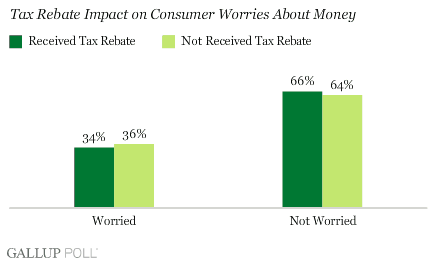
Commentary
Gallup's survey results suggest that much of the impact of the special tax rebates this year may have already been, or will soon be, realized. More than half of those in the $24,000 to $90,000 a year, middle-income group have already received their rebates. Importantly, the IRS will end the first mailings of the tax rebates by July 11, and the program was designed so that not everyone will receive a rebate.
Further, the stimulating effect of the tax rebates may be limited to its direct spending aspects, at best. There seems to be little likelihood that the tax rebates will stimulate additional non-rebate related consumer spending since they have done little, if anything, to improve consumer confidence.
Survey Methods
Gallup is interviewing no fewer than 1,000 U.S. adults nationwide each day during 2008. The rebate and economic questions analyzed in this report are based on combined data of more than 20,000 interviews in April, May and June. For results based on this sample, the maximum margin of sampling error is ±1 percentage point. The questions for June 10-16 are based on combined data of more than 3,000 interviews. For results based on this sample, the maximum margin of sampling error is ±2 percentage point.
In addition to sampling error, question wording and practical difficulties in conducting surveys can introduce error or bias into the findings of public opinion polls.
To provide feedback or suggestions about how to improve Gallup.com, please e-mail feedback@gallup.com.
